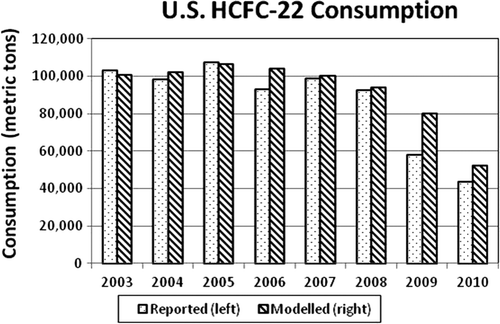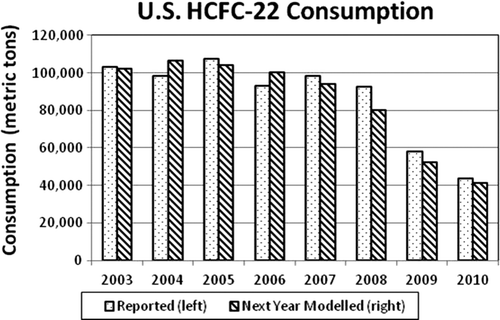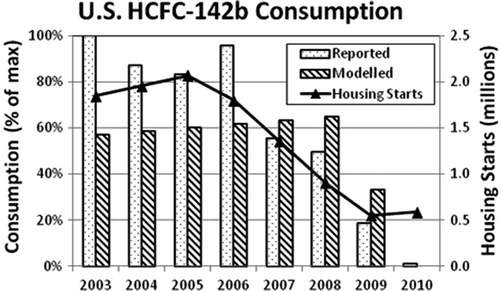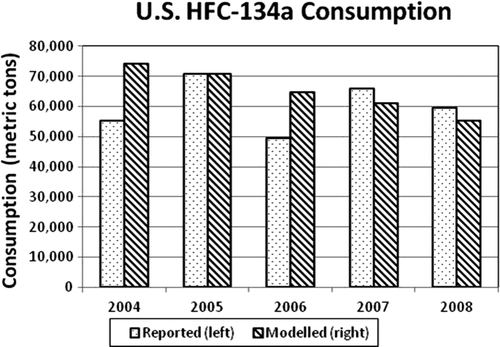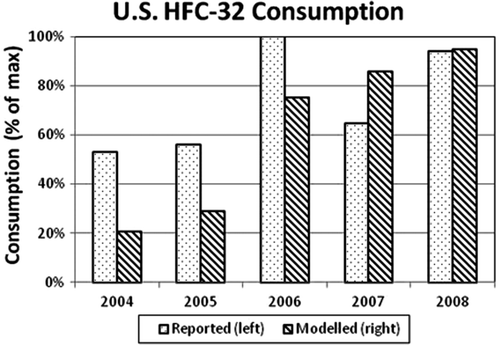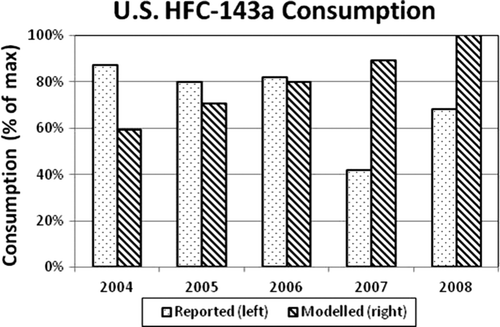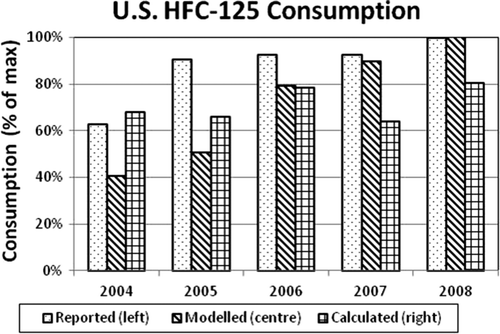Abstract
In preparing inventories of ozone-depleting substance (ODS) substitutes, primarily hydrofluorocarbons, the US employs models consistent with Tier 2 methodologies from the 2006 IPCC Guidelines for National Greenhouse Gas Inventories. The model calculates chemical consumption and emissions for 60 sub-applications, which are aggregated to five application levels. So-called “bottom-up” models require data and assumptions regarding the sub-application industries, including number of products introduced and retired each year, the type and amount of chemicals initially used, the emission pattern of the chemicals and if any released chemical is replaced. Once developed, the bottom-up model's estimates of chemical demand can be compared to “top-down” chemical consumption or sales. Combining these types of data gives a partial picture of the amount of ODS and substitutes introduced to the US economy. This paper examines the top-down data in comparison to the bottom-up estimates derived from the inventory models and discusses possible explanations for the differences noted.
1. Introduction
FootnoteHydrofluorocarbons (HFCs) are manufactured for specific uses and generally are not emitted as a by-product of other processes.Footnote2 More importantly, for many applications, HFCs are currently the principal alternatives for ozone-depleting substances (ODSs), the consumption of which is being phased out globally (UNEP Citation2011a) under the Montreal Protocol on Substances that Deplete the Ozone Layer. Although HFCs constitute only a small portion of greenhouse gas (GHG) emissions, they are forecasted to grow, reflecting increased demand for refrigeration and air conditioning, particularly in developing countries, and substitution for ODS. Growth of HFCs, if left unconstrained or weakly regulated, is anticipated to contribute significantly to global warming (Velders et al. Citation2009). For these reasons, the demand for HFCs is analysed here. Specifically, this paper compares reported consumption patterns and modelled demand for three ODSs and four HFCs used as ODS replacements, explores possible reasons for inconsistencies and identifies types of information that could help resolve those inconsistencies. indicates the primary sector(s) where several ODSs have been used in the US and the HFCs used, often in blends, as replacements.
Table 1. ODSs and replacements.
Substitutes for ODSs constitute the majority of HFC emissions from many countries, including the US. As an emission category reported under the United Nations Framework Convention on Climate Change, ODS substitutes include several applications, including refrigeration and air conditioning, fire suppression, aerosols, solvents and foams. Within any application, several sub-applications can exist, such as domestic refrigeration, commercial refrigeration, industrial processes, transport refrigeration, stationary air conditioning and mobile air conditioning. When preparing national inventories, many countries develop data at an even finer level of detail. Many of these sub-applications use multiple chemicals due to competition from chemical suppliers, long equipment lifetimes, economic pressures to maintain existing equipment, phaseout regulations and company policies.
The IPCC (2006) provides Tier 2 disaggregated (sub-application level) methodologies for estimating ODS substitute emissions. As explained therein, developing a complete inventory of the emission category often requires a combination of both chemical sales (top-down) data and sub-application market (bottom-up) data.
This paper examines results from the bottom-up Vintaging Model used by the United States Environmental Protection Agency (USEPA) to estimate GHG inventories from the ODS substitute category. These results are compared to top-down chemical consumption information available for ODSs and HFCs. This paper analyses these two basic datasets and offers possible explanations for the differences seen.
2. Bottom-up and top-down data
2.1. Bottom-up data from USEPA's Vintaging Model
The Vintaging Model estimates emissions from five ODS substitute applications: air conditioning and refrigeration, foams, aerosols, solvents and fire suppression. There are approximately 60 independently modelled sub-applications. For each sub-application, the model requires information on market growth, the transition from ODS to alternatives and characteristics such as market size, charge sizes and emission patterns. Data sources and input assumptions for the model are provided in USEPA (Citation2011).
The “bottom-up” model calculates chemical consumption based on the quantity of equipment sold, serviced and retired each year, and the amount of the chemical required to manufacture and/or maintain the equipment. The model builds an inventory of the in-use stocks of the equipment and ODSs and HFCs in each of the sub-applications. Emissions are estimated by applying annual and disposal emission rates to each population of equipment. By aggregating across the different sub-applications, the model produces estimates of annual use and emissions of each chemical at the application level. The simulation is considered to be a “business-as-usual” baseline case, and does not incorporate measures to reduce emissions other than those required by US law or otherwise common in the industry.
In the development of chemical demand information, the Vintaging Model assumes that some chemical is recovered from retired refrigeration, air conditioning and fire protection equipment. Such recovered material is not included in the net chemical demand data used in this analysis. Also, chemical demand is assumed to occur when a product is placed on the market, regardless of when the chemical or product was actually manufactured. No distinction is made regarding where the chemical may have been produced and, if not produced domestically, whether it entered into the US in a bulk shipment or inside products already containing the chemical.
A Monte Carlo uncertainty analysis was performed on the emissions resulting from 26 of the 60 sub-applications; these 26 sub-applications comprise 97% of the estimated 2009 ODS substitute emissions. The results indicate an uncertainty range of approximately −7% to +8% for a 95% confidence interval (USEPA Citation2011). Although this uncertainty range is for emissions and covers only a portion of the model, we use this range when evaluating how closely estimated demand from the model aligns with the top-down consumption data, and consider a difference to be “significant” if it exceeds that range.
2.2. Top-down data from the USEPA's Tracking System (ODS)
Under Article 7 of the Montreal Protocol, countries annually report on the consumption (production plus imports less exports) of ODS by chemical type (UNEP Citation2011b). To do this, USEPA requires entities to report all ODS bulk chemical production, import and export, regardless of quantity, using USEPA's ODS Tracking System. Companies are not required to report ODS chemical contained in equipment such as closed-cell foams and pre-charged air conditioners. Although individual company data are considered confidential business information, aggregated results are publicly available from the Ozone Secretariat's Data Access Centre (UNEP Citation2011c).
These top-down reported data are used in the analysis below. The Montreal Protocol does not limit the amount of ODS produced or consumed if such consumption transforms the chemical. Hence, the data used in this paper purposefully exclude such feedstock production. Due to the confidentiality of the data, in this paper HCFC-141b consumption is only shown for 2003–2008, and values are plotted as a percentage of the modelled 2003 value.
2.3. Top-down data provided voluntarily (HFCs)
The US law also requires reporting of HFCs and other GHGs supplied to the US economy as detailed in Title 40 of the US Code of Federal Regulation, Part 98 (GPO Citation2011). This paper was started before reporting under these regulations was required. Since that time, requirements for reporting 2010 bulk consumption data have become effective. Although that data have been reported, as of the date of submission of this paper, the reporting of that data, even in aggregate or general terms, remains completely blocked. Hence, data from this source are not included here.
Prior to the establishment of these requirements, several companies voluntarily supplied confidential information on the production, import and export of HFCs for 2004–2006, and then again for 2007–2008. Although only a limited number of companies participated, it is expected that the reports constituted over 90% of the US market for bulk HFCs. Like ODS, any consumption as feedstock was purposefully excluded. Because the reported consumption only comes from a limited number of companies, data for HFC-32, HFC-125 and HFC-143a are shown on a relative scale.
3. Results and discussion
3.1. Comparison of HCFC-22 consumption and chemical demand
graphs the consumption of HCFC-22 (chlorodifluoromethane) as determined from the ODS Tracking System for the years 2003–2010 and the chemical demand as calculated by the Vintaging Model. There is generally good agreement, especially from 2003 to 2008, between the two types of data.Footnote3 From 2003 to 2008, only the 2006 modelled demand differs from the reported consumption by more than the uncertainty range discussed above (i.e. 12% difference and a −7% to +8% uncertainty range). This generally good agreement might be expected as the larger markets for HCFC-22 have existed for many years and there is a reasonable amount of publicly available data from which to build the bottom-up estimates.
Without significant manipulations of the model, however, the bottom-up results do not reflect the market variability seen in the reported top-down information. For instance, the model does not reflect the 2005–2007 data that show first a decline and then an increase in consumption. One might presume the 2006 decline was due to the decline of a major source of HCFC-22 consumption, namely new central air conditioners and air-source heat pumps (also called unitary equipment), and may explain why estimated demand for that year exceeded reported consumption by a significant amount. Indeed, the shipments of this equipment declined from over 8.6 million units in 2005 to less than 7.1 million units in 2006 (AHRI Citation2011). However, such shipments decline again to 6.4 million units in 2007, which might not be expected given the reported top-down data. The 2006 decrease does not seem to have been made up by alternatives such as R-410A, R-507A and R-404A.Footnote4 As shown below, although top-down consumption of HFC-32 increased over 75% from 2005 to 2006, there was no significant increase in either HFC-125 (2% increase) or HFC-143a (3% increase) during those years.
Under US law, beginning in 2010 new HCFC-22 chemical was only allowed to service equipment placed on the market in 2009 or earlier. As a result, during the 2008–2010 timeframe, equipment manufacturers transitioned much of their production to use HFCs. Both the top-down data and bottom-up modelled results show this trend, although the model appears to over-predict the remaining HCFC-22 demand, significantly so for 2009 and 2010.
The decrease in reported consumption in 2009 and 2010 (63% and 47% of the 2008 consumption, respectively) shows a steeper drop than the modelled 2009 and 2010 demand (85% and 56% of the 2008 estimate, respectively). Because 2009–2010 HFC data were not available, it remains to be seen whether this drop in HCFC-22 consumption was matched by an increase in consumption of HFC alternatives. It may also be speculated that the model over-predicts service demand while under-predicting demand for new equipment, by amounts that lead to relatively good agreement when both types of demand were dominated by HCFC-22 but less agreement as demand for HCFC-22 in new equipment declined while demand for servicing existing equipment continued at roughly stable levels.
Because the top-down data are reported at the time of actual production or import and the bottom-up data are calculated at the time of actual placement on the market, there could be a temporal discrepancy when comparing data. For instance, it might be that actual chemical production occurs primarily in the latter half of the year, and then is sold both to equipment manufacturers, wholesalers and distributors. This is supported by the temporally variant nature of shipments of unitary equipment, the largest sub-application use of HCFC-22 in the US. In 2010, over 75% of unitary shipments occurred in the first 8 months, and 46% in the months of March–June (AHRI Citation2010). Likewise, given that cooling-only equipment dominates the US market, it is likely that the service need for additional refrigerant remains unnoticed until temperatures begin to increase, during the spring months. To test this hypothesis, plots the reported consumption against the modelled demand for the following year. This method does show a slightly better correlation than shown in .Footnote5 Nonetheless, the differences in reported consumption and modelled demand are still significant in some of the years, again showing the difficultly in capturing the market variability observed.
3.2. Comparison of HCFC-141b consumption and chemical demand
plots data for HCFC-141b (1,1-dichloro-1-fluoroethane). It is clear that the model does not reflect the dynamic nature of the reported chemical consumption, with significant differences seen in each year. Whereas the model projects a slowly declining demand, the actual consumption switches from positive to negative (indicating more chemical exported than produced or imported in a given year), at relatively low levels after 2004.
HCFC-141b is primarily used as a foam-blowing agent in several types of polyurethane foam (UNEP Citation2010). In the US, HCFC-141b consumption was tightly controlled in 2003 (GPO Citation2003). Regulations that took effect then set up a petition process to allow consumption only for thermal protection on space vehicles, cleaning of oxygen equipment and aircraft parts, and certain insulating spray and pour foam applications. Furthermore, effective November 2004, USEPA found HCFC-141b unacceptable for foam-blowing applications, also with exceptions for low-volume uses (GPO Citation2004). This decision eliminated the option of importing a foam system pre-formulated with HCFC-141b and using it to produce polyurethane spray foam.Footnote6
Many companies utilize “swing plants” that produce either HCFC-141b or another chemical but not both at the same time. To reduce costs and inefficiencies, it is expected that HCFC-141b would be made in large batches, and then requirements for the chemical would be drawn down from those supplies over time. This fact, combined with the phasedown in allowances and allowed uses described above, fits the pattern seen in the top-down data. We can infer that part of the production in 2003 was actually used then, and that supplies from that production, plus minor amounts in 2006, were then used in subsequent years 2004–2008.
The modelled data do not track the minor exemptions described above. Instead, the demand is estimated as that required for the production of foam that would be used in the US, almost exclusively as insulation on domestic refrigerator-freezers. Although the production of such foam is unacceptable within the US, HCFC-141b foam on such products is still used in some other countries. In order to track emissions in the US, the model reflects foam made with HCFC-141b in other countries and then imported. Therefore, the top-down tracking system, which does not account for chemical included in imported products, does not help to correlate the model. Instead, further research into the nature of the products imported is required to determine whether the model accurately estimates HCFC-141b use and emissions.
3.3. Comparison of HCFC-142b consumption and chemical demand
Both HCFC-142b (1-chloro-1,1-difluoroethane) datasets in show similar trends during 2004–2006 (roughly stable market) and 2008–2010 (declining to near-zero). However, the modelled estimates are far lower than the reported consumption in 2003–2006, but exceed it in 2007–2009. In all of the years, the modelled demand differs from the reported consumption by a significant amount.
The HCFC-142b is used primarily as a foam-blowing agent; its US demand is dominated by the extruded polystyrene (XPS) boardstock industry (UNEP Citation2010). Among other uses, XPS foam is employed for insulating roofs and walls of new-construction homes. To see if there is a correlation with this use, plots new privately owned housing starts (US Census Bureau Citation2011). Not all new homes use XPS boardstock, and HCFC-142b and XPS boardstock foam are used for other purposes; nonetheless, the new housing starts data reflect the trends seen in the reported consumption data for 2003–2009.Footnote7
Likely there is not much XPS foam imported or exported, except perhaps short distances across the US–Mexico or US–Canada borders (Rouse Citation2010). So, unlike as seen in HCFC-141b, the nature of the reported data and the modelled estimates should not cause significant differences. Both the top-down and bottom-up data reflect zero or nearly so consumption in 2010. This is expected, as regulations restricted HCFC-142b consumption for service of existing products, eliminating its use for manufacturing foam in the US (GPO Citation2009). While both the reported data and modelling estimates reflect a transition away from HCFC-142b from 2008 to 2010, the reported values indicate a shrinking market starting in 2007. This may be a transition of some production lines, or might reflect the decline in housing starts. Hence, more research on the HCFC-142b market, and how it might correlate to housing starts, is recommended as a way to improve the bottom-up modelling.
3.4. Comparison of HFC-134a consumption and chemical demand
The HFC-134a (1,1,1,2-tetrafluoroethane) data are shown in . We see that bottom-up modelling matches top-down reporting for some years, but not others. For 2004 and 2006, the reported data are a significant 25% and 23%, respectively, below the modelled data. In 2005, 2007 and 2008, the modelled data are 92–100% of the reported values.
The HFC-134a is the most widely employed HFC and is manufactured globally for numerous sub-applications. First commercialized around 1990, HFC-134a use became widespread as a refrigerant in mobile air conditioning, high-pressure chillers and stand-alone refrigeration equipment. It is also used in refrigerant blends, such as R-404A and R-407C,Footnote8 as a foam-blowing agent, an aerosol propellant and other sub-applications. The largest market for HFC-134a is as a mobile air conditioning refrigerant, accounting for ∼50% of HFC-134a consumption in developed countries (Velders et al. Citation2009).
The top-down consumption reported data show market fluctuations not fully captured by the model. The relatively lower amount in 2004 followed by the higher amount in 2005 is likely due partially to short-term supply issues caused by manufacturing interruptions (Contracting Business Citation2004). That is, supplies desired but not delivered in 2004 were likely compensated by additional 2005 supply. It is not clear whether a similar situation occurred in 2006, when reported consumption is lowest in the five years shown. Although not yet reportable, 2010 and 2011 reporting may show similar effects due to additional shortages and price volatility (Pawlowski Citation2011).
The model shows a downward trend from 2005 to 2008, also seen in the 2007–2008 reported values, coming from a combination of three prominent effects. First, over this time period there was a decline in sales of new vehicles, which use HFC-134a as the air conditioning refrigerant, and, secondly, there has been a downward trend in the average charge size of such air conditioners since they were first introduced (USEPA Citation2009). Thus, both first-fill requirements and service requirements declined, as seen in . Thirdly, by 2004 some HFC-134a products were retired, and recovered and possibly reclaimed supplies (not shown in either datasets) helped offset demand for virgin HFC-134a. Such recovery and reuse are assumed in the model, but remain speculative at this point in the reported consumption data. More information on any reuse is needed to account for this effect.
Additional study is needed to assess the differences between the top-down and bottom-up data. For instance, as mobile air conditioners are generally pre-charged with refrigerant, import/export balances should cause differences between the two datasets. While it is known that the US is a net importer of vehicles, an accounting of not just the number of vehicles but the amount of refrigerant contained in their air conditioners is needed for this comparison.
3.5. Comparison of HFC-32, HFC-143a and HFC-125 consumption and chemical demand
The HFC-32 (difluoromethane), HFC-143a (1,1,1-trifluoroethane) and HFC-125 (pentafluoroethane) are shown in –, each graphed as a percentage of the highest top-down or bottom-up value in the time period to maintain confidentiality. For all three refrigerants, the model under-predicts the reported data for 2004–2006. For 2007–2008, however, the model over-predicts the reported consumption for HFC-32 and HFC-143a while accurately reflecting the HFC-125 data.
The majority of each of these three chemicals' use is in refrigerant blends with one of the other chemicals. The HFC-125 is used by itself as a fire protection agent; however, this use is estimated to be small compared to its use in blends with HFC-143a (mainly R-404A and R-507A) or with HFC-32 (such as R-410A).Footnote9 Neat HFC-32 is being investigated as a refrigerant for unitary air conditioners, but such products are not currently available in the US (Wilkins and Stanga 2011). Hence, we expect the HFC-32 and HFC-143a trends to be strongly reflected in the HFC-125 trends.
The largest market for HFC-32 is residential and light commercial air conditioning in refrigerant blends such as R-407C and R-410A. Although significant differences are seen in the 2004–2007 data, both the top-down and bottom-up HFC-32 results show a steep increase in 2006. This is due in part to new energy-efficiency requirements for new residential central air conditioners (which used either HCFC-22 or R-410A) that took effect in 2006. To meet these requirements, many units employed larger condensers, increasing the amount of refrigerant needed. This increase was offset by lower sales of unitary products in 2006 compared to 2005 (AHRI Citation2011). The increase also comes from the gradual transition from ODS to alternative blends with HFC-32, a pattern predicted by the model for this chemical as well as for HFC-125 and HFC-143a.
The decrease in reported consumption of HFC-32 from 2006 to 2007 is hypothesized to be due to manufacturing strategies. Observing that this same drop did not occur in HFC-125, we conclude that HFC-32 was made in abundance in 2006, providing stockpiles that were used in 2007. For 2004–2005, the differences between the reported and modelled HFC-32 and HFC-125 data may stem from the use of R-407C and R-410A in products made and filled with refrigerant in the US, but exported to other regions where demand for them was higher (i.e. Europe). However, because there is a closer match in 2006–2008, additional factors may exist, such as new production lines outside the US or reporting errors. Alternatively, the model could be underestimating the penetration of this refrigerant into the domestic market in the early years. Additional information, such as a breakdown of air-conditioning equipment production and export by refrigerant type, is needed to confirm these possibilities.
The largest market for HFC-143a is large retail food (i.e. supermarkets) in refrigerant blends such as R-404A and R-507A. The HFC-143a reported data show a steep decline in 2007, regaining some of that loss in 2008. Although some commercial refrigeration blends with HFC-143a are used in exported products (e.g. small freezers), these amounts are not significant compared to bulk chemical use in supermarkets. Further, while some supermarket owners have committed to reduce charge sizes and lower leak rates (GreenChill Citation2007), it does not appear that those actions would be enough to show the decrease seen here, considering both a somewhat higher reported HFC-143a consumption in 2008 and a relatively steady HFC-125 market. Hence, further investigation, including a check for reporting errors, is needed.
The two largest markets for HFC-125 are residential and light commercial air conditioning in refrigerant blends such as R-407C and R-410A and large retail food (i.e. supermarkets) in refrigerant blends such as R-404A and R-507A. These markets show an approximate 40/60 split in the years 2003–2008; however, the use in air conditioning is expected to dominate consumption in the near future. A steep increase in reported HFC-125 occurred in 2005, a year before the HFC-32 increase. Because a similar increase is not seen in the HFC-143a data, it might be assumed that this was advanced production in anticipation of higher R-410A demand to meet efficiency requirements. Also plotted in is the calculated consumption of HFC-125 as determined by the top-down reporting of HFC-32 and HFC-143a. To calculate this amount, we redistribute the 2006–2007 HFC-32 consumption to show a linear progression to the 2008 value, but with the same total, assuming 2006 production of HFC-32 was held over for 2007. Next, we assume all HFC-32 is used in R-410A and all HFC-143a is used in R-404A. The calculated values are different than the reported totals, notably lower in 2005–2008. While the differences in the latter 2 years may be due primarily to the influences noted above in HFC-143a, the 2005–2006 data may be due to an unusually high demand for HFC-125 for other uses, such as fire protection, or in blends where the amount of HFC-125 is higher than those for R-404A and R-410A, such as R-507A, R-407A or R-417A.Footnote10 Alternatively, the data may reflect a long-term strategy to produce HFC-125 before producing HFC-32 and/or HFC-143a to create the blends required by the market.
4. Conclusion
Using a Tier 2 bottom-up methodology to estimate HFC emissions requires detailed information on multiple sub-applications where each chemical is used, often relying on assumptions or expert judgement. Comparing the model's estimates of chemical demand with bulk chemical consumption reported by a generally limited scope of entities can be used to validate the model, but limitations must be examined.
For widely used chemicals, such as HCFC-22 and HFC-134a, relatively good correlation is seen between bottom-up modelled chemical demand and top-down reported consumption. This is due to the long history of use and the availability of data, especially for dominant sub-applications, for these chemicals. Regardless, the modelling cannot easily reflect some market fluctuations, such as shortages or early production for later use, and further information on the recovery and reuse from discarded equipment would be valuable.
For chemicals that are being phased out or are only recently introduced, modelling results can be quite different than reported consumption. In some cases, gathering additional data on related industries may help to correlate the model. For example, chemicals used for foam in the domestic refrigerator and home insulation markets may help correlate HCFC-141b and HCFC-142b modelling results, respectively, with the reported consumption data. Timing of production is important for markets that fluctuate by season, such as HCFC-22, as well as for chemicals that might be made in large batches and deployed from stockpiles, such as HCFC-141b. Also, for any particular chemical that is imported/exported within products in relatively large amounts, including HCFC-22, HCFC-141b, HFC-134a, HFC-32 and HFC-125, detailed knowledge of such information is needed to understand potential differences.
Acknowledgements
The author provides special thanks to the companies that voluntarily supplied HFC consumption estimates for 2004–2008. The author also thanks Jennifer Bohman, Staci Gatica, Mike James and Deborah Ottinger-Schaefer of the USEPA, who helped gather the top-down consumption data.
Notes
1. Any opinions expressed in this paper are those of the author and not necessarily those of the United States Environmental Protection Agency.
2. The HFC-23 is an exception. Although HFC-23 does have some specific uses for fire protection, semiconductor manufacturing and cryogenic refrigeration, the majority of HFC-23 emissions occur as a by-product in the manufacture of HCFC-22.
3. A correlation of the modelled data as a function of the reported data yields an r 2 value of 0.906 but with a slope of 0.75 (1.0 is ideal) and an intercept at 27,161 metric tons (0 is ideal).
4. R-410A is a mixture of 50% by weight HFC-32 and 50% HFC-125. R-507A contains 50% HFC-125 and 50% HFC-143a. R-404A contains 44% HFC-125, 52% HFC-143a and 4% HFC-134a.
5. A correlation of the modelled data as a function of the reported data yields an r 2 value of 0.929, a slope of 1.05 and an intercept at −6732 metric tons.
6. Pre-formulated foam systems, even if they contained HCFC-141b, were not controlled by the allowance and petition process established by the 2003 regulation, but would be accounted for in the modelled demand.
7. A correlation of housing starts as a function of the reported data yields a 0.88 r 2 value.
8. R-407C is a mixture of 23% by weight HFC-32, 25% HFC-125 and 52% HFC-134a.
9. The Vintaging Model estimates that in 2009, less than 2% of HFC-125 demand was as a fire protection agent, while over 96% of demand was as a component in refrigerant blends R-404A, R-410A and R-507A.
10. R-407A is a mixture of 20% by weight HFC-32, 40% HFC-125 and 40% HFC-134a. R-417A contains HFC-125 but not HFC-32 nor HFC-143a.
References
- AHRI . 2010 . Monthly shipments , Arlington , VA : Air-Conditioning, Heating, and Refrigeration Institute . [cited 2011 Aug 26]. Available from: http://www.ahrinet.org/monthly+shipments.aspx
- AHRI . 2011 . Central air conditioners and air-source heat pumps historical data , Arlington , VA : Air-Conditioning, Heating, and Refrigeration Institute . [cited 2011 Aug 26]. Available from: http://www.ahrinet.org/central+air+conditioners+and+air_source+ heat+pumps+historical+data.aspx
- Contracting Business . 2004 . DuPont says shortage of HFC-134a will be short term. 1 October 2004 , Cleveland , OH : Penton Media, Inc . [cited 2011 Aug 26]. Available from: http://contractingbusiness.com/refrigeration_bits/cb_imp_6044/
- GPO . 2003 . Fed Regist [2003 Jan 21; cited 2012 Apr 25];68:2820–2863. Available from: http://www.gpo.gov/fdsys/pkg/FR-2003-01-21/pdf/03-95.pdf
- GPO . 2004 . Fed Regist [2004 Sep 30; cited 2012 Apr 25]; 69:58269–58280. Available from: http://www.gpo.gov/fdsys/pkg/FR-2004-09-30/pdf/04-21809.pdf
- GPO . 2009 . Fed Regist [2009 Dec 15; cited 2012 Apr 25];74:66412–66448. Available from: http://www.gpo.gov/fdsys/pkg/FR-2009-12-15/pdf/E9-29569.pdf
- GPO . 2011 . Electronic code of federal regulation, protection of the environment (Title 40), mandatory greenhouse gas reporting (Part 98) , Washington , DC : US Government Printing Office . [cited 2011 Aug 26]. Available from: http://www.gpoaccess.gov/cfr/index.html
- GreenChill . 2007 . GreenChill advanced refrigeration partnership launch event , Washington , DC : US Environmental Protection Agency . [2007 Nov 27; cited 2011 Aug 27]. Available from: http://epa.gov/ozone/partnerships/greenchill/downloads/GCLaunchBrochure.pdf
- IPCC . 2006 . “ 2006 intergovernmental panel on climate change guidelines for National Greenhouse Gas Inventories ” . In Prepared by the National Greenhouse Gas Inventories Programme , Edited by: Eggleston , H S , Buendia , L , Miwa , K , Ngara , T and Tanabe , K . Japan : IGES .
- Pawlowski . 2011 . HFC-134a duster pricing rides the “perfect storm.” Technical White Paper, Kevin Pawlowski, Techspray , Amarillo , TX : Techspray . [2011 May 5; cited 2011 Aug 26]. Available from: http://www.eis-inc.com/files/pdf/supplier_showcase_page_downloads/techspray/Duster_Price_Volatility_Whitepaper_050311.pdf
- Rouse . 2010 . Comment submitted by Rob Rouse, Global Climate Change Regulatory Affairs Leader, The Dow Chemical Company. Document ID EPA-HQ-OAR-2009-0927-0119 [2010 Jun 11; cited 2012 Apr 25]. Available from: http://www.regulations.gov
- UNEP . 2010 . 2010 rigid and flexible foams report , Nairobi , , Kenya : United Nations Environment Programme, Ozone Secretariat . [cited 2012 Apr 25]. Available from: http://ozone.unmfs.org/Assessment_Panels/TEAP/Reports/FTOC/FTOC-2010-Assessment-Report.pdf
- UNEP . 2011a . Status of ratification , Nairobi , , Kenya : United Nations Environment Programme, Ozone Secretariat . [cited 2011 Aug 26]. Available from: http://ozone.unep. org/new_site/en/treaty_ratification_status.php
- UNEP . 2011b . Online treaties/instruments , Nairobi , , Kenya : United Nations Environment Programme, Ozone Secretariat . [cited 2011 Aug 26]. Available from: http://ozone.unmfs. org/new_site/en/Treaties/treaty_text.php
- UNEP . 2011c . Data access centre , Nairobi , , Kenya : United Nations Environment Programme, Ozone Secretariat . [cited 2011 Aug 26]. Available from: http://ozone.unmfs. org/new_site/en/ozone_data_tools_access.php
- US Census Bureau . 2011 . New privately owned housing units started , Washington , DC : US Census Bureau . [cited 2011 Aug 26]. Available from: http://www.census.gov/const/startsan.pdf
- USEPA . 2009 . ODS and ODS substitutes in the mobile air conditioning sector (preliminary) , Washington , DC : US Environmental Protection Agency . [2009 Aug 27]
- USEPA . 2011 . Inventory of US greenhouse gas emissions and sinks: 1990–2009 (EPA report 430-R-11-005). Available from: http://www.epa.gov/climatechange/emissions/usinventory report.html
- Velders , G , Fahey , D , Daniel , J , McFarland , M and Andersen , S . 2009 . The large contribution of projected HFC emissions to future climate forcing, 2009 . PNAS , 106 ( June )
- Wilkins , R and Stanga , M . Technical options to HCFCs for unitary air-conditioning systems . Presentation at the Indo-US workshop on Hydrofluorocarbons . [2011 Feb 18; cited 2012 Apr 25]. Available from: http://www.ozonecell.com/uploads/files/1298358645805-1WHATA∼1.ppt
